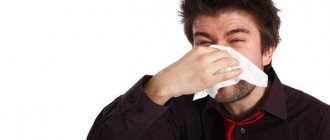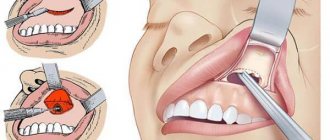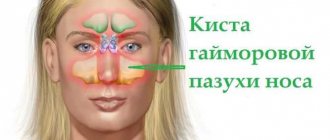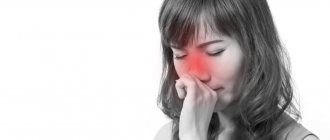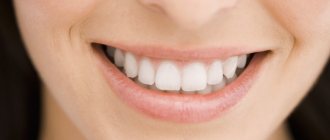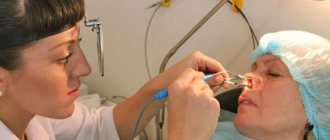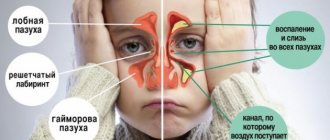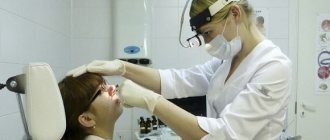Indications for the procedure
Puncture of the maxillary sinus is not prescribed for absolutely all patients with otorhinolaryngological problems. It is carried out only after a thorough examination. First, the doctor must collect anamnesis and conduct an objective examination. Next, he prescribes non-invasive diagnostic methods, that is, those that do not require damage to the skin, such as puncture.
Diagnostic puncture of the maxillary sinus is performed only in cases where, after carrying out all of the above methods, any ambiguities remain. But a therapeutic puncture is done with the aim of alleviating symptoms and improving the patient’s condition.
The main indications for this procedure may be as follows:
- prolonged headaches, the cause of which cannot be determined by other means;
- accumulation of a large amount of pus in the sinus;
- to study the contents of a maxillary sinus cyst;
- taking a biopsy for examination under a microscope if an oncological process is suspected;
- For therapeutic purposes, puncture is performed when drug therapy is ineffective and in the presence of bacterial inflammation in the maxillary sinus.
https://youtu.be/https://www.youtube.com/watch?v=w0WGNgwtUFY
_
Rumors around puncture of the maxillary sinus
And now it’s time to stop at the rumors swirling around the puncture of the maxillary sinus, and distinguish truth from fiction, born of fear of Kulikovsky’s needle.
Rumor #1. If you have done the puncture once, you will have to repeat it often.
It seems that this rumor has spread due to the fact that some patients are forced to periodically puncture their maxillary sinuses.
However, this tendency is not at all associated with “getting used to” the puncture. Can the body “get used to” and adapt to surgical intervention? A puncture for sinusitis is just an “artificial hole” that allows you to get rid of stagnant purulent secretions. After overgrowth of bone tissue, the maxillary sinus acquires almost its original appearance. So how many punctures are done for sinusitis? Of course, one. Repeating the puncture, as a rule, is the lot of those whose sinusitis takes a severe chronic form. And this is most often due to the existence of any risk factors that complicate the treatment of the disease.
Rumor No. 2. Puncture is the most difficult and dangerous procedure
We have already described the stages of puncture and tried to reassure readers and convince them that puncture is an unpleasant, but still not a monstrous method of treating sinusitis.
Rumor #3. The puncture is dangerous: serious complications may await you after it
There is no grain of truth in this rumor. A puncture performed by a good specialist is completely safe and does not pose a threat to health. If you entrust the puncture of the maxillary sinus to a 3rd year medical student, complications are quite real: the hand of an amateur can direct the Kulikovsky needle past the wall of the maxillary sinus. Then, instead of puncturing the maxillary sinus, a buccal or ocular puncture is performed, which, of course, is not included in the operation plan. However, all these horrors do not threaten you if a surgeon gets down to business.
Rumor No. 4. The puncture is done by those doctors who do not want or do not know how to treat sinusitis in other ways.
In fact, a puncture is a necessary necessity. There are situations where, without emergency surgical intervention and removal of pus, severe complications, including life-threatening ones, can develop within a few hours. Therefore, sometimes a puncture is an emergency measure for which there is simply no alternative. And if life, or rather, illness, presented you with a “surprise” in the form of a puncture of the maxillary sinus, squeeze lemon juice out of this lemon, and in the future do not neglect your health.
Previous Surgical treatment of sinusitis
Next Cuckoo - hardware lavage of the maxillary sinuses
Procedure technique: first stage
Before the puncture, the mucous membrane of the nasal passage is treated with an anesthetic solution. This is necessary to prevent pain. To dilate the vessels and excretory duct of the sinus, the patient is injected with an adrenaline solution. The puncture of the maxillary sinus is carried out through the lower nasal passage.
For puncture, a needle is used, the end of which is curved. If this is not available, then a lumbar puncture needle can be used. The doctor carefully inserts it into the lower nasal passage to a depth of 2.5 cm, while carefully monitoring the process. The needle should rest against the arch of the nasal passage. This place was not chosen by chance. This is where the bone is thinnest, so the puncture is easiest to make.
After this, the needle advance changes towards the orbit. At all times, the doctor should hold the patient’s head with one hand and the needle with the other. This prevents the instrument from moving and damaging the sinus wall. It is possible to change the injection site if the initially selected location is not flexible enough.
How does this procedure work?
Puncture of the maxillary sinus is a surgical procedure. But the word “surgical” should not frighten the patient, because every practicing ENT doctor knows the technique of this manipulation and thoroughly knows the sequence outlined below:
Anemization. The first stage is necessary in order to “drain” the surgical field, thereby improving visualization and minimizing blood loss by the patient during manipulation. To implement this stage, medications that have a powerful vasoconstrictor effect are used. The vessels narrow, therefore, less blood flows into the treated area. This ensures the proper anemization effect.- Anesthesia (pain relief). In 99% of cases, local anesthesia is performed. There are 2 main options: terminal and infiltration anesthesia. In the first case, the anesthetic is applied to a cotton swab, which is inserted into the nasal cavity. But in the case of infiltration anesthesia, an injection is performed. It is extremely rare (up to 1% of all cases of manipulation) that doctors resort to anesthesia (general anesthesia). The use of this option for pain relief may be associated with severe background pathology, as well as with the presence of complications that make it difficult to perform the manipulation according to the standard scheme.
- Puncture. The doctor inserts a special needle (Kulikovsky needle) into the lower nasal passage and reaches the upper point of the vault. It is necessary to pierce here, since the thickness of the bone wall in this area is minimal. The doctor punctures the side wall of the maxillary sinus and advances the needle into the latter by 1.2-1.5 cm. Next, a syringe is attached to the needle, which removes the contents from the cavity. Afterwards, the sinus is thoroughly washed, an antiseptic is administered, possibly also an antibiotic (at the discretion of the attending physician).
The figure above shows the puncturing procedure.
Note! After performing the procedure, the patient is recommended to take a position with his head tilted forward and down for a while.
This is necessary in order to ensure the outflow of liquid contents, which can still be quite actively released for some time.
In some cases, patients have a catheter installed directly into the cavity of the maxillary sinuses. This approach ensures the outflow of exudate, which can be secreted by the mucous membrane of the sinuses during the first few days after the treatment procedure. However, catheter placement is approved and therefore not practiced by all otolaryngologists.
Subsequent stages of the procedure
The next stage of the maxillary sinus puncture technique is to check the patency of the anastomosis. Further medical tactics depend on its results. If the syringe plunger is pulled out easily and then does not return back, it means that the anastomosis is passable. Another sign of patency is that fluid from the sinus flows freely into the nasal cavity. In this case, it is necessary to carefully remove the fluid in the sinus.
Next, the doctor rinses the sinus with antiseptic solutions. The patient's head is tilted down and forward. A tray is placed under the patient's head to collect the liquid. This position prevents it from entering the throat or upper respiratory tract.
If necessary, at this stage a puncture of the maxillary sinus can be performed with the administration of medications. In this case, doctors administer antibiotics and proteolytic enzymes.
If it is determined that the anastomosis is impassable, the doctor makes another puncture. The sinus is washed through two needles.
The fluid obtained as a result of the puncture is collected in a sterile tube and sent for analysis to the laboratory.
If punctures are performed regularly, a catheter is inserted into the hole in the nasal passage. Further punctures are made through this tube. This method deprives the doctor of the need to make a new puncture every time.
The procedure for puncture of the maxillary sinuses
Puncture for sinusitis
This manipulation is not as complicated and scary as it is commonly thought, and is generally carried out on an outpatient basis. The basis for the puncture is the results of a diagnostic examination (tomography, ultrasound in children and pregnant women), which shows the fluid level. In rare cases, the patient is given anesthesia (more often in children). Anesthesia is performed by introducing a tampon with an anesthetic solution into the nasal passages.
After loss of sensitivity of the nasal passages, a special curved needle is used to puncture the side wall of the nasal passage, then the contents - mucus, pus - are evacuated with a syringe. The cavity is carefully washed with saline solution, then an antibacterial solution (antibiotics, antiseptics, enzymes) is introduced.
Often there is a need for repeated punctures. In these cases, a thin drainage catheter is inserted, which is fixed to the skin and used for rinsing until permanent improvement occurs.
Many people know that there is a laser method for treating sinusitis. But it in no way excludes puncture when there is pus in the cavity. The laser method is very good, but as an addition to the main methods of treatment, as well as for chronic and catarrhal sinusitis.
Contraindications to the procedure
Therapeutic and diagnostic puncture of the maxillary sinus, like any other study, has a number of contraindications.
This procedure should not be performed on young children because their sinuses are not yet as developed as those of an adult.
It is not recommended to carry out intervention for people with severe concomitant diseases: diabetes mellitus in the stage of decompensation, high blood pressure, severe failure of internal organs. Such patients should limit any invasive interventions as much as possible, as this may lead to a worsening of their condition.
People with mental disorders are also prohibited from this procedure.
A separate group of patients is identified for whom it is simply impossible to perform a sinus puncture. This may be due to a thick bone wall or the presence of pathology in its development.
Complications after the procedure
Complications during puncture of the maxillary sinus are very rare. However, sometimes they still happen. The following undesirable effects may occur:
- A sharp decrease in blood pressure, or collapse. This is manifested by marble pallor, blue lips. Possible clouding of consciousness.
- A common purulent inflammation of the orbit is phlegmon. Appears due to the ingress of pus from the sinus.
- Damage to cheek tissue from a needle.
- Infectious blood poisoning, or sepsis. Occurs when bacteria penetrate from the sinus into the bloodstream.
- Soft tissue hematoma due to arterial damage.
- Bleeding.
- Embolism of a blood vessel. This happens very rarely when air accidentally penetrates into the sinus, and then into the vessels.
One of the most common complications is collapse. To help the patient in this situation, it is necessary to tilt him forward. This simple technique increases blood pressure by squeezing the abdominal aorta. Afterwards, the patient is placed horizontally and the lower limbs are elevated to increase the flow of venous blood to the heart. If these techniques do not increase blood pressure, caffeine benzoate is injected under the skin.
Consequences of violation of puncture technique
If, during a puncture of the maxillary sinus, the doctor moves the needle in the wrong direction or punctures too deeply, the upper or posterior wall of the sinus may be damaged.
When the upper wall is punctured, fluid flows into the orbit. This can lead to the development of inflammation in the tissues of the eye: conjunctivitis, iritis, iridocyclitis, blepharitis. If assistance is not provided in a timely manner, vision and eye mobility may deteriorate.
If the doctor was careless to pierce the back wall of the sinus, the needle will fall into the palatine fossa. This will cause blood to accumulate inside the facial bone and form a hematoma.
Is the procedure painful?
Many patients undergoing puncture of the maxillary sinus are concerned about its pain. Contrary to popular belief, the procedure is absolutely painless. There may be an unpleasant feeling of fullness after the antiseptic solution gets on the mucous membrane. But it passes quickly.
According to reviews, the feeling when administering an anesthetic is the same as in dentistry. Due to its use, the pain syndrome is completely eliminated.
A positive attitude plays an important role during a puncture. There is such a thing as the placebo effect. If the patient “winds up” himself before the intervention, then during the procedure itself he may actually be in pain. And all because of self-hypnosis.
Therefore, before the puncture, the doctor must tell the patient in detail about all stages of the procedure in order to reassure him.
Sinusitis. Who did the puncture? After a puncture, what are the consequences? Has it gotten worse or what?
Answers:
Daria Veselik
I didn’t get a puncture, but I know that my friends who got a puncture didn’t get rid of it, and besides, getting a puncture is a terrible pain, as if your brains are being sucked out
Isok
It may not be better, but it might be better...
Zina Zeta
It doesn’t get better even after the twenty-fourth puncture; I have a friend whose sinuses were pricked 24 times and after a couple of months pus began to accumulate again. Drink colloidal silver and wash your nose with its solution and everything will go away after 2-3 courses of treatment.
Zhanna Kurylenko
They did it for my husband, everyone tried to dissuade him, but he still decided, after which he greatly regretted it) Now he can’t sleep at all, he wakes up 5-6 times at night) he got hooked on naphthyzin, bottles are everywhere, he just tried a lot of nasal drops and came to the conclusion that this is the only drug that helps him, although it is addictive. I do not recommend getting a puncture.
*-*[FOX]*_*
I did, the thing was not pleasant, there was no more sinusitis
Anton Rudkovsky
Puncture of the maxillary sinus is a therapy of despair when nothing else helps. We need to do everything possible to do without this. The consequences are chronicity of the process and vasomotor rhinitis.
Ivan Krusenstern
Yes, in theory there is nothing wrong with getting a puncture, no, for example, I got a puncture three times, but then it’s such a relief. This good condition after a puncture (for me) lasts about 1 year. After this you need to pierce again.
7yu3e7r9grYUE
Just pierce it once... and off we go.
Tanya
My son had a puncture 5 years ago. Thank God he is already 20 and everything is fine. But there could be trouble, the doctor explained that it happens that pus spills out.
Lyudmila
If there is pus in the sinus, then punctures need to be done (but punctures are not always done for sinusitis (sinusitis), it all depends on the image, this is decided by the ENT doctor, sometimes you can treat without a puncture. If you don’t do a puncture, but you really need it, then pus can be organized and there may be polyps, etc. Popular opinion - It’s worth piercing once... and off we go, it’s completely wrong, this is how people who are far from ENT diseases argue, and unfortunately some doctors. It’s just that the nose is a weak point and next time it’s as soon as If you catch a cold, first of all you need to put drops in your nose. Sometimes if you don’t make a puncture in time, you can be treated for a long time and without results, and in terms of money the treatment will cost 2-3 times more. Whether you make a puncture or not, a mark remains on the iris, and you can follow it determine what the person was sick with and when. Those patients whom I know and to whom we performed punctures became better. The cause of sinusitis can be a severe cold or bad teeth in the upper jaw (odontogenic cause), vasomotor rhinitis. — may occur due to a deviated nasal septum and vegetative-vascular dystonia (VSD).
Maria Prokhorova
There's no point.
Andrey
I agree with Lyudmila. puncture of the maxillary sinus is not a therapy of despair. It is a very effective procedure that allows you to remove pus from the maxillary sinus in a timely manner. however, as a rule, those patients are punctured for whom nothing else helps, or who have taken a long time to decide on such a procedure. in such patients whose disease is already advanced. Therefore, it is not surprising that the popular opinion is that “once you make a puncture, that’s it, chronicles” about pain - everything is, of course, subjective. however, I was injected twice - and nothing happened, I survived, and I didn’t even scare other patients near the office with screams 
Nasal congestion after piercing
The main purpose of a puncture of the maxillary sinus is to remove or reduce nasal congestion. But there are cases (reviews confirm this) when the condition only worsens. What are the reasons for this paradox?
Firstly, congestion after the procedure may appear as a reflex reaction to a puncture of the mucous membrane, which swells, which prevents a person from breathing. In such cases, the symptom occurs immediately after the intervention. With further therapy the swelling goes away.
Another option is when congestion appears a certain time after the procedure. This indicates its insufficient effectiveness. There may still be microorganisms in the sinus. In addition, you need to consider the possibility of infectious processes nearby. For example, dental caries. Allergic reactions can also cause nasal congestion.
Treatment after punctures
If the puncture of the maxillary sinus was performed for a diagnostic study, then antibiotic therapy is prescribed after the test.
Congestion may be observed for some time after the puncture. For further treatment, vasoconstrictor drops and antihistamines are used, and glucocorticoid sprays are prescribed to relieve swelling. To speed up the resorption process, physiotherapy is often prescribed.
For a week after the manipulation, you do not need to visit the pool, bathhouse, sauna, or swim in natural bodies of water.
How many punctures are done?
The number of punctures of the maxillary sinus largely depends on the type of procedure (diagnostic or therapeutic). If the procedure is carried out for the purpose of diagnosis and collection of material, as a rule, one puncture is enough for this.
At the same time, if medications are administered during a puncture, the course usually consists of 3-5 punctures.
In today's medicine, puncture of the maxillary sinus is an emergency method. It is prescribed only when there is a threat of infection spreading beyond the sinus or when other medicinal methods are ineffective. For banal sinusitis, treatment with an oral or parenteral antibiotic is sufficient. And there is no need to do a puncture, like other unpleasant procedures (such as “cuckoo”).
Source: fb.ru
Recovery after a puncture of the maxillary sinus
Bone tissue has enormous recovery potential.
Its cells - osteoblasts - regularly synthesize bone matrix, and when bones are damaged, they are activated and work even more efficiently. Therefore, soon after the wall of the maxillary sinus is punctured, only memories remain of the additional hole. The inflammatory process after puncture of the maxillary sinuses is also impossible: during the recovery course, antibiotics are necessarily prescribed to prevent complications. Moreover, if during the puncture material was taken for cultural testing, doctors are given a unique opportunity to prescribe an antibacterial drug to which the pathogens are sensitive, and not hit the roof with a finger.
If culture was not necessary and sensitivity to antibiotics was not determined, drugs are prescribed empirically. This is not the first time that doctors have treated sinusitis and its complications “by touch.” The list of bacteria that like to multiply in the maxillary sinuses has long been known, so there are no difficulties in selecting medications. The main key to success is the patient’s discipline. It is extremely important to scrupulously follow all the doctor’s instructions and complete the course of antibiotics from start to finish. Drink and be calm about complications after the puncture.
We advise you to study: Capillary therapy for sinusitis: popular information about turpentine
Indications for use
One of the indications for puncture of the maxillary sinus is its cyst.
Typically, a puncture of the maxillary sinus is performed after a detailed examination of the patient, assessment of the results of endoscopic and x-ray examination of the paranasal sinuses and a thorough study of their structure. After all, the maxillary sinus may have its own individual characteristics, for example, being two-chambered or not having an orbital wall. And in the case of traumatic sinusitis, it may have cracks or contain bone fragments.
However, it should be noted that puncture of the maxillary sinus is resorted to in extreme cases, when the benefits from it justify all sorts of risks. This is due to the fact that the procedure is not safe for the patient and can cause a number of complications. Let's consider situations when puncture is necessary.
- Ineffectiveness of conservative treatment in the presence of a purulent inflammatory process in the maxillary sinus.
- Persistent headaches and symptoms of intoxication.
- Difficulty in draining pus from the sinus.
- Cyst of the maxillary sinus (taking its contents for analysis).
- Tumor process (sampling of material for histological examination).
- Differential diagnosis.
Contraindications for nose piercing
Puncture of the maxillary sinus is not prescribed for all patients. It is contraindicated in the following conditions:
- Infectious sinusitis in the acute stage.
- Abnormal development of the bony sinuses.
- Sinusitis due to exacerbation of chronic diseases.
- History of mental disorders.
- Violation of the blood clotting process.
Contraindications include the patient's age.
Nose piercing for sinusitis is not done for infants, children under 3 years of age, or elderly people. This is an invasive procedure. It involves the destruction of natural bone barriers. Such an intervention is associated with additional penetration of infectious agents into the body, bleeding and other risks.
Contraindications
In some cases, puncture of the maxillary sinus is undesirable or contraindicated. Thus, this intervention is not carried out in young children (due to anatomical features and underdevelopment of the nasal sinuses), in persons with severe somatic diseases (decompensated diabetes mellitus, severe heart failure, resistant hypertension with high blood pressure numbers, etc.) and blood diseases. In this case, the allergy history and mental state of the patient must be taken into account.
In some patients, the puncture is difficult, and sometimes impossible, to carry out technically. This happens when there is a too thick and dense bone wall in the sinus or abnormalities in its development.
Sometimes a puncture cannot be carried out using the usual method, then it requires an individual approach, which requires certain skills from the doctor.
Operation stages
Sinus puncture is performed in several stages:
- First, local anesthesia is given and the projection of the nasal canals is innervated. Turundas made of cotton wool, generously soaked in anesthetic medicine, are inserted into the nostrils using tweezers.
- Where the sinus wall is thin (bottom and middle), the doctor makes a puncture using a Kulikovsky needle.
- Through the resulting hole, a pathological secretion, as well as purulent exudate (if any), is pumped out with a syringe.
- Then they begin to wash the sinuses, for which an instrument such as a trocar and an antibiotic solution is used. The patient's head should be tilted forward, the mouth opening slightly open - this will prevent pus from flowing into the throat. When the medicinal suspension is completely absorbed, the manipulation is carried out again.
- If it is necessary to remove the fluid naturally, the patient lies down on the couch - directly on the side on which the puncture was made.
By the way, when the described operation is performed on a child, not local, but general anesthesia is used.
A Kulikovsky needle is used directly for puncture
For rinsing you can use:
- saline;
- Miramistin;
- sodium chloride solution;
- Chymotrypsin.
It is possible that after minimally invasive therapy, the doctor will send the patient for x-rays. And in order to relieve the symptoms of the remaining phenomena, you will have to use anti-inflammatory and bactericidal drugs, as well as analgesics.
For five days after surgery, the sinuses are washed, for which they resort to antibacterial liquid. If a catheter is inserted, subsequent treatment of the sinuses lasts about 10 days.
Miramistin is used for washing and treating the sinuses after a puncture
The essence of the technique
Puncture of the maxillary sinus is carried out through the lower nasal meatus. Before the procedure, its mucous membrane is irrigated with anesthetic solutions (lidocaine, dicaine or trimecaine). To dilate the vessels of the anastomosis and improve the patency of the excretory duct of the maxillary sinus, the middle nasal passage is treated with adrenaline.
For intervention, a special needle with a curved beveled end or a lumbar puncture needle is used. Under visual control, it is inserted into the lower nasal passage to a shallow depth (2-2.5 cm) and rests against its arch. In this place, the bone wall has a minimum thickness, so the puncture is easier to perform. Further advancement of the needle should be directed towards the outer corner of the orbit. When performing a puncture, the doctor fixes the patient’s head with one hand and the needle with the other. This prevents its displacement and injury to the walls of the sinus. If it is not possible to pierce the wall right away, the specialist can change the direction of the needle, finding a more pliable area.
After inserting the needle into the sinus, it is moved in the opposite direction by 0.2-0.3 cm in order to free its lumen from tissue fragments that accidentally got there. After making sure that the needle is in the right place, the doctor uses a syringe to try to obtain the contents of the sinus. If the fluid in the maxillary sinus is under pressure, it immediately begins to flow out. Contents of a serous nature are especially easily released. Thick masses (pus) do not disappear on their own.
At the next stage, the doctor checks the patency of the anastomosis, since his further actions depend on this. If the syringe piston can be pulled out easily and it does not return back (to its original position), then the patency of the anastomosis is preserved. Also, normal patency is indicated by the leakage of washing fluid into the nasal cavity. In this case, the doctor can carefully remove the contents of the sinus, rinse it with antiseptic solutions and administer the necessary medication (antibiotics, proteolytic enzymes). When rinsing, the patient's head is tilted down and forward so that the liquid pours into the tray and does not fall into the throat. If the anastomosis is impassable, then the doctor installs a second needle, and rinsing is done through two needles. After the procedure, the patient is placed on his side so that fluid does not spill out of the anastomosis, and his condition is monitored for 30 minutes.
The contents of the maxillary sinus obtained in this way are placed in a sterile tube and sent for analysis to the laboratory.
If for one reason or another multiple punctures are planned, then after the first procedure a special tube or catheter is inserted into the resulting hole and all subsequent manipulations are carried out through it.
How is a puncture done for sinusitis?
We will not mislead readers by convincing them that getting a piercing is pleasant. Of course, puncture is not the most harmless technique, which is why it is used only in extreme cases, when other types of help have been exhausted. Let's look at the puncture in detail and find out whether it hurts to get a puncture with sinusitis and what sensations may arise during the operation.
Anesthesia
Before the procedure, the doctor will certainly administer local anesthesia. Tetracaine, lidocaine 4% and a combination of an anesthetic and a vasoconstrictor, most often adrenaline, can be used as anesthetics. A swab moistened with medicine is wrapped around a thin spatula and inserted deep into the nasal cavity.
You shouldn’t worry that “the anesthesia won’t work.” Such tales are more suitable for average movies and heroes of bearded jokes, and not for real life. The doctor will definitely check how effectively the “field of activity” is anesthetized and, if necessary, will introduce an additional dosage of anesthetic.
Therefore, the answer to the most painful question in every sense, which does not give sleep or rest to a person who is preparing to pierce the maxillary sinus, is simple and unpretentious. There will be no painful shock during the puncture, just as there will be no pain at all. The only unpleasant sensation that cannot be avoided is a fairly loud crunching sound during puncture of bone tissue. We perceive the sound that actually signals the piercing of a bone as being quite loud also because we hear it “from within.”
We advise you to study: Surgical treatment of sinusitis
And, of course, you can’t turn off the visual analyzer either. The patient observes the procedure and voluntarily surrenders to the mercy of the surgeon, allowing him to insert a huge needle into the nasal cavity and carry out bloody manipulations with it. Valerian extract or any other sedatives taken half an hour before the puncture will help you cope with emotions.
Puncture
After the doctor is convinced of the effectiveness of local anesthesia, he inserts a needle into the nasal sinus, bearing the name of the famous Soviet otorhinolaryngologist Kulikovsky. It is a very intimidating long tubular device with thick walls, curved at the distal part and equipped with a cannula. With its help, the needle is easily connected to the syringe.
With this very Kulikovsky needle, the doctor “feels” the surgical area - the thinnest zone in the wall of the maxillary sinus - and pierces it with a slight movement of the hand.
Washing
After performing several correct and unnoticeable movements for the suffering patient, the surgeon makes sure that the needle is located in the lumen of the sinus, after which he begins to rinse. Using a syringe connected to a Kulikovsky needle, an antiseptic solution is injected into the maxillary sinus. The pus, liquefied by the medicine, finally leaves its home. The sinus is washed until the washouts become clear, without any admixture of blood or pus.
By the way, the patient should be prepared for the fact that during the rinsing process his eyes will not see the most pleasant picture. Blood from the damaged sinus and purulent discharge will flow into the tray, carefully supported by the nurse’s hand. In this case, the consolation can be the thought that it is better to observe these substances in a tray under your nose than to carry them in your maxillary sinus.
After washing, the barbaric procedure of puncturing the maxillary sinus, according to thousands of patients, comes to its logical conclusion. The patient goes home, equipped with a prescription with further prescriptions.
Complications
Puncture is performed through the lower nasal passage, having previously treated the nasal mucosa with an anesthetic solution.
In most cases, such interventions go well, but sometimes complications develop. Let's take a closer look at them.
- Collaptoid reaction. The patient develops severe pallor, blue lips, blood pressure drops, and loss of consciousness may occur. To provide first aid, the patient is tilted forward, thereby squeezing the abdominal aorta and increasing the pressure, then placed on a horizontal surface with the lower limbs raised, and a caffeine benzoate solution is injected subcutaneously.
- Orbital phlegmon as a result of perforation of the sinus walls.
- Penetration of the needle into the soft tissue of the cheek.
- Air embolism of the vessels of the brain or heart is extremely rare when air is forced into the sinus and enters a blood vessel.
- Hematogenous spread of infection.
- Hematoma due to injury to an artery.
- Bleeding.
A competent specialist can avoid many unwanted reactions by using the correct technical approach and taking into account the individual characteristics of the patient’s body.
